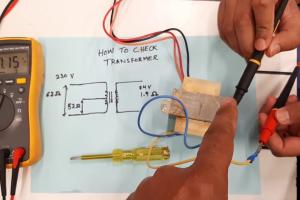Comprehensive Guide on How to Test a Transformer: Techniques & Tools

-
Quick Links:
- Introduction
- What is a Transformer?
- Importance of Testing Transformers
- Types of Transformers
- Common Transformer Failures
- Testing Methods
- Step-by-Step Guide to Test a Transformer
- Tools Needed for Testing
- Case Studies
- Expert Insights
- Conclusion
- FAQs
Introduction
Transformers are essential components in electrical systems, facilitating the transfer of electrical energy between circuits. Yet, just like any other equipment, they require thorough testing to ensure reliability and efficiency. In this article, we will explore the various methods of testing transformers, delve into the reasons for testing, and provide a comprehensive step-by-step guide for professionals and DIY enthusiasts alike.What is a Transformer?
A transformer is an electrical device that converts alternating current (AC) from one voltage level to another. It operates on the principle of electromagnetic induction and is widely used in power distribution networks. Transformers can step up (increase) or step down (decrease) voltage levels, making them crucial for efficient power transmission.Importance of Testing Transformers
Testing transformers is vital for several reasons: - **Safety:** Faulty transformers can lead to safety hazards such as electrical fires. - **Efficiency:** Regular testing helps maintain optimal performance and energy efficiency. - **Longevity:** Early detection of issues can extend the lifespan of transformers. - **Compliance:** Many industries require compliance with safety and operational standards.Types of Transformers
Understanding the types of transformers is essential for effective testing. Common types include: - **Step-Up Transformers:** Increase voltage from primary to secondary coils. - **Step-Down Transformers:** Decrease voltage from primary to secondary coils. - **Isolation Transformers:** Provide electrical isolation between circuits. - **Autotransformers:** Use a single winding for both primary and secondary circuits.Common Transformer Failures
Common issues that may necessitate transformer testing include: - **Short Circuits:** Often caused by insulation failure. - **Overheating:** Can result from excessive load or poor ventilation. - **Core Failures:** Lead to reduced efficiency and increased losses. - **Mechanical Failures:** Include physical damage or loose connections.Testing Methods
Various testing methods can be used to assess transformer functionality: 1. **Insulation Resistance Testing** 2. **Power Factor Testing** 3. **Transformer Turns Ratio (TTR) Testing** 4. **Sweep Frequency Response Analysis (SFRA)** 5. **Dissolved Gas Analysis (DGA)**Step-by-Step Guide to Test a Transformer
Testing a transformer involves several steps. Below is a detailed guide:Step 1: Safety Precautions
- Always wear personal protective equipment (PPE). - De-energize all power supply connections. - Ensure proper grounding of equipment.Step 2: Visual Inspection
- Check for physical damage, leaks, or signs of overheating. - Inspect all connections and terminals.Step 3: Insulation Resistance Testing
- Use a megohmmeter to measure insulation resistance. - Ensure the resistance value is within the manufacturer's specifications.Step 4: Power Factor Testing
- Connect a power factor meter to the transformer. - Measure the power factor and compare it with standard values.Step 5: Transformer Turns Ratio (TTR) Testing
- Use a TTR tester to assess the turns ratio. - Ensure that the ratio is consistent with the transformer's design.Step 6: Sweep Frequency Response Analysis (SFRA)
- Perform SFRA to identify mechanical deformations. - Analyze the frequency response to detect internal issues.Step 7: Dissolved Gas Analysis (DGA)
- Collect oil samples and analyze for dissolved gases. - Identify any abnormal gas levels indicating internal faults.Step 8: Evaluate Test Results
- Document all findings and compare them against acceptable criteria. - Identify any areas requiring maintenance or repairs.Tools Needed for Testing
To effectively test a transformer, the following tools are essential: - **Megohmmeter:** For insulation resistance testing. - **Power Factor Meter:** To measure power factor. - **Transformer Turns Ratio Tester:** For assessing turns ratio. - **Dissolved Gas Analyzer:** For performing DGA. - **Multimeter:** For general electrical measurements.Case Studies
1. **Case Study: Insulation Resistance Failure** - A power utility company faced repeated outages due to transformer failures. Upon testing, they discovered low insulation resistance. Subsequent maintenance increased reliability and reduced outage rates. 2. **Case Study: Overheating Issues** - A manufacturing plant noticed overheating in their transformers. Power factor testing revealed poor performance, leading to timely interventions that enhanced efficiency and safety.Expert Insights
Experts recommend a routine testing schedule for transformers, ideally every 12 to 18 months, depending on the environment and load conditions. Regular checks not only improve safety but also optimize performance, ensuring minimal downtime and enhanced energy savings.Conclusion
Testing transformers is a critical aspect of electrical maintenance that ensures safety, efficiency, and longevity. By following the methods outlined in this guide and employing the necessary tools, professionals can effectively manage transformer health and performance.FAQs
1. How often should transformers be tested?
Transformers should be tested every 12 to 18 months or as required based on operational conditions.
2. What is insulation resistance testing?
Insulation resistance testing measures the resistance of the insulating material to prevent current leakage.
3. What is the purpose of dissolved gas analysis?
DGA helps identify internal faults by analyzing gases dissolved in transformer oil.
4. Can I test a transformer without specialized tools?
While some basic tests can be performed, specialized tools provide more accurate and comprehensive results.
5. What are the signs of a failing transformer?
Common signs include overheating, unusual noises, and frequent tripping of circuit breakers.
6. Is transformer testing necessary for small units?
Yes, even small transformers require testing to ensure safety and reliability.
7. Can transformer testing prevent future failures?
Yes, regular testing can identify potential issues before they lead to failures.
8. What is power factor testing?
Power factor testing assesses the efficiency of a transformer by measuring the phase difference between voltage and current.
9. How can I improve transformer efficiency?
Regular maintenance and timely testing can help improve transformer efficiency.
10. What should I do if I find a fault during testing?
Immediately consult with a qualified electrician or engineer for assessment and repairs.
Random Reads